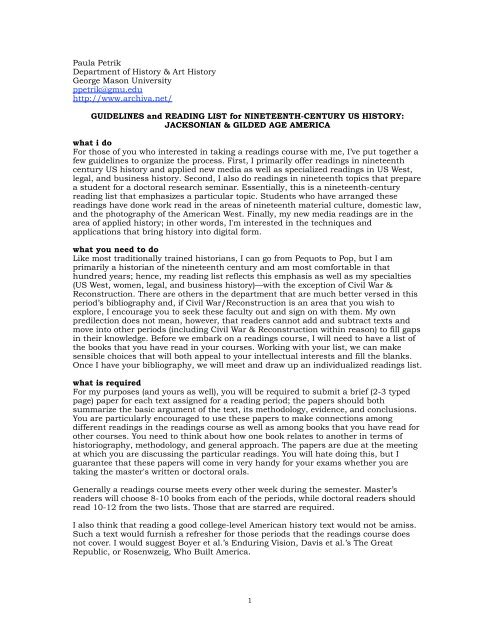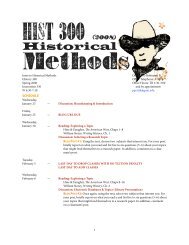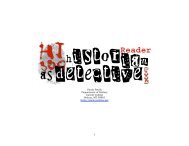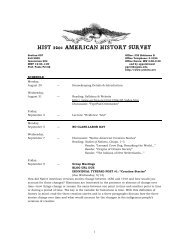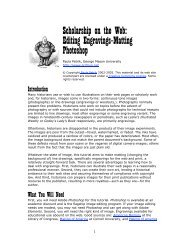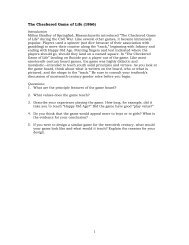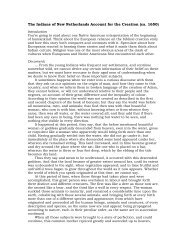Download Reading List PDF - Paula Petrik | George Mason University
Download Reading List PDF - Paula Petrik | George Mason University
Download Reading List PDF - Paula Petrik | George Mason University
- No tags were found...
You also want an ePaper? Increase the reach of your titles
YUMPU automatically turns print PDFs into web optimized ePapers that Google loves.
<strong>Paula</strong> <strong>Petrik</strong>Department of History & Art History<strong>George</strong> <strong>Mason</strong> <strong>University</strong>ppetrik@gmu.eduhttp://www.archiva.net/GUIDELINES and READING LIST for NINETEENTH-CENTURY US HISTORY:JACKSONIAN & GILDED AGE AMERICAwhat i doFor those of you who interested in taking a readings course with me, I’ve put together afew guidelines to organize the process. First, I primarily offer readings in nineteenthcentury US history and applied new media as well as specialized readings in US West,legal, and business history. Second, I also do readings in nineteenth topics that preparea student for a doctoral research seminar. Essentially, this is a nineteenth-centuryreading list that emphasizes a particular topic. Students who have arranged thesereadings have done work read in the areas of nineteenth material culture, domestic law,and the photography of the American West. Finally, my new media readings are in thearea of applied history; in other words, I'm interested in the techniques andapplications that bring history into digital form.what you need to doLike most traditionally trained historians, I can go from Pequots to Pop, but I amprimarily a historian of the nineteenth century and am most comfortable in thathundred years; hence, my reading list reflects this emphasis as well as my specialties(US West, women, legal, and business history)—with the exception of Civil War &Reconstruction. There are others in the department that are much better versed in thisperiod’s bibliography and, if Civil War/Reconstruction is an area that you wish toexplore, I encourage you to seek these faculty out and sign on with them. My ownpredilection does not mean, however, that readers cannot add and subtract texts andmove into other periods (including Civil War & Reconstruction within reason) to fill gapsin their knowledge. Before we embark on a readings course, I will need to have a list ofthe books that you have read in your courses. Working with your list, we can makesensible choices that will both appeal to your intellectual interests and fill the blanks.Once I have your bibliography, we will meet and draw up an individualized readings list.what is requiredFor my purposes (and yours as well), you will be required to submit a brief (2-3 typedpage) paper for each text assigned for a reading period; the papers should bothsummarize the basic argument of the text, its methodology, evidence, and conclusions.You are particularly encouraged to use these papers to make connections amongdifferent readings in the readings course as well as among books that you have read forother courses. You need to think about how one book relates to another in terms ofhistoriography, methodology, and general approach. The papers are due at the meetingat which you are discussing the particular readings. You will hate doing this, but Iguarantee that these papers will come in very handy for your exams whether you aretaking the master's written or doctoral orals.Generally a readings course meets every other week during the semester. Master’sreaders will choose 8-10 books from each of the periods, while doctoral readers shouldread 10-12 from the two lists. Those that are starred are required.I also think that reading a good college-level American history text would not be amiss.Such a text would furnish a refresher for those periods that the readings course doesnot cover. I would suggest Boyer et al.’s Enduring Vision, Davis et al.’s The GreatRepublic, or Rosenwzeig, Who Built America.1
Jacksonian America1. Paul Johnson, Shopkeeper's Millennium—social history of religious revivals2. Alexis de Toqueville, Democracy in America—what to say about a classic **3. Karen Halttunen, Confidence Men & Painted Women: A Study of Middle-classCulture in America, 1830-1870—a good read on the mentalite´ in the US4. John Kasson, Rudeness & Civility: Manners in Nineteenth Century Urban America—a good cultural history on something not much thought about5. Larry Levine, High Brow Meets Low Brow: American Culture as an IntellectualConcern—a look at cultural taste and its origins6. Suzanne Lebsock, The Free Women of Petersburg—very good book on women inVirginia in early 19th century7. Harry Watson, Liberty and Power—very good overview of Jacksonian period; focuson market revolution8. Paul Johnson and Sean Wilentz, The Kingdom of Matthias—lively narrative of anearly religious “cult.”9. Sean Wilentz, Chants Democratic—important book on industrialization andworkers in NYC10. Tom Dublin, Women and Work: The Transformation of Work and Community inLowell, Massachusetts—A quantitative look at the changes in women’s industriallabor11. Alan Taylor, William Cooper’s Town—an absorbing study of the politics andeconomics of land development in the years after the American Revolution12. Mary Ryan, Cradle of the Middle Class—a classic on women’s role in the formationof the middle class13. Patricia Cline Cohen, The Murder of Helen Jewett—a murder serves as the focusfor an exploration of gender, public display, and the press14. Linda Gordon-Reed, Thomas Jefferson and Sally Hemmings: An AmericanControversy—an interesting discussion of a historical puzzle and controversy fromboth the legal and historical perspectives15. Amy Gilman Srebnick, The Mysterious Death of Mary Rogers: Sex and Culture inNineteenth-Century New York—An exploration of changing gender roles, sexuality,and law16. Karen Haltunnen, Murder Most Foul: The Killer and the American GothicImagination—A cultural look at homicide and changing interpretations of theperpetrator17. Michael Grossberg, Governing the Hearth: Law and Family in Nineteenth-CenturyAmerica—An excellent study in the transformation of family law and the legalinterpretations of gender2
18. Laurel Thatcher Ulrich, The Age of Homespun: Objects and Stories in the Creationof the American Myth—A look at objects and how these objects illuminate thetransformation of economics, politics, and gender relations19. James P. Ronda, Lewis & Clark Among the Indians—A different perspective on theCorps of Discovery and its encounters with native peoples20. Robert Rimini, Andrew Jackson: The Course of American Freedom: 1822–1832—This is the second volume in Rimini’s exhaustive biography and the mostinteresting21. Colin Calloway, One Long Winter Count—A very long book, but if you read onebook on Native American history, this should be it.22. Susan Johnson, Roaring Camp—What could be better than a social history of theGold Rush?Gilded Age1. Frederick Jackson Turner, The Significance of the Frontier in American History—Another one of those must reads and an example of “grand theory”**2. Robert Wiebe, The Search for Order—an extremely influential synthesis of theyears 1877-1920.3. Gail Bederman & Catharine R. Stimpson, Manliness and Civilization: A CulturalHistory of Gender and Race in the United States, 1880-1917—an interestingexploration of the topics during the Gilded Age4. Alan Trachtenberg, The Incorporation of America: Culture and Society in the GildedAge—survey of late nineteenth century from a largely cultural perspective.5. Edward Kirkland, Dream and Thought in the Business Community, 1860-1900—anexceptionally short but trenchant work on the business thinking6. Alfred Chandler, The Visible Hand: The Managerial Revolution in AmericanBusiness—a basic text for understanding the structure of business in America7. Gretchen Ritter, Goldbugs and Greenbacks: The Antimonopoly Tradition and thePolitics of Finance in America—a good look at an aspect of business and theeconomy that has permeated American history8. Lawrence Goodwyn, The Populist Moment (the abridged version of his very long TheDemocratic Promise)—a very important reinterpretation of populism. [see articlesin Journal of American History that comment on Goodwyn, e.g. James Turner,"Understanding the Populists" (Sept. 1980); see Steve Hahn, “The Roots ofSouthern Populism” for an important local study.9. Henry Adams, The Education of Henry Adams—An Adams without a job? What’sleft but to observe the events and people around him**10. Richard Hofstadter, Age of Reform—a classic interpretation of populism (Youshould look at a more modern treatment if you select this text.)11. Steven P. Erie, Rainbow’s End: Irish Americans and the Dilemmas of UrbanMachine Politics—A major study of Irish American political organizations3
12. Patricia Limerick, Legacy of Conquest—the book that ignited the “new westernhistory”13. James Cook, The Arts of Deception: Playing with Fraud in the Age of Barnum—Astudy of mass entertainment and the greatest “humbug” of them all.14. William Cronon, Nature’s Metropolis—A combination of environmental and urbanhistory explaining why Chicago grew and became the urban center of theAmerican heartland15. David Emmons, The Butte Irish—A look at immigration in one of the largestindustrial cities in the American West16. Nell Irvin Painter, Standing at Armageddon: The United States, 1877–1919—Areadable account of Gilded Age that includes good discussions of race and gender17. Regina Morantz-Sanchez, Conduct Unbecoming a Woman: Medicine on Trial inTurn-of-the-Century Brooklyn—A trial serves as the focus for women’sprofessionalism, the development of journalism, and urban identity18. Linda Gordon, The Great Arizona Orphan Abduction—A microhistory thatexamines ethnicity, gender, race in all its complexity19. Mark Twain, The Gilded Age—First published in 1873, the novel is a biting satireand stark portrait of post-Civil War America20. Louis Menard, The Metaphysical Club—Pragmatism was America’s contribution tothe philosophical canon, and this intellectual history examines the lives andthought of those who articulated its tenets21. Rebecca Edwards, New Spirits: Americans in the Gilded Age—A good overview withan excellent discussion of sources that will point you in new directions22. Martha Sandweiss, Print the Legend—The development of photography andphotographing the American West23. Philip Deloria, Indian in Unexpected Places—Contrary to popular misconception,Native Americans didn’t vanish but turned up in “unexpected places”4


